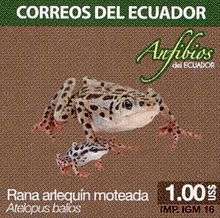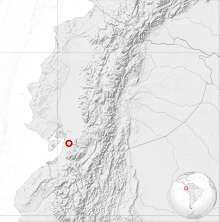Atelopus balios
| Atelopus balios | |
|---|---|
 | |
| Scientific classification | |
| Kingdom: | Animalia |
| Phylum: | Chordata |
| Class: | Amphibia |
| Order: | Anura |
| Family: | Bufonidae |
| Genus: | Atelopus |
| Species: | A. balios |
| Binomial name | |
| Atelopus balios | |
 | |
Atelopus balios, the Rio Pescado stubfoot toad, is a species of toad in the family Bufonidae. It is endemic to southwestern Ecuador, with records from Pacific lowlands in Azuay, Cañar, and Guayas Provinces.[1][3] It is a rare species that was already suspected to be extinct,[1] but a single specimen was discovered in 2011 by a team from Conservation International during a hunt for missing amphibians.[4][5][6][7] The decline in amphibian populations is well documented. The Atelopus balios is possibly extinct as a result of the widespread amphibian Chytridiomycosis fungus that has decimated other amphibian populations.[8]
Description
Adult males measure 27–29 mm (1.1–1.1 in)[4] and females 35–37 mm (1.4–1.5 in) in snout–vent length.[9] The snout is The limbs are long and slender. The fingers and toes are partially webbed.[2] The dorsum is olive green and is covered with rounded black spots that also extend to the limbs. The palms, soles, webbing, and perianal region are orange. The belly is almost totally cream yellow, except for the margins to which the black spots extend.[9]
Habitat and conservation
Its natural habitats are tropical lowland rainforests at elevations of 200–460 m (660–1,510 ft)[1] or 0–900 m (0–2,953 ft)[4] above sea level, depending on the source. It is nocturnal and associated with streams.[4] It is threatened by chytridiomycosis and habitat loss caused by agriculture, logging, and pollution. Its range does not include any protected areas.[1][4]
References
- 1 2 3 4 5 Cisneros-Heredia, D.; Yánez-Muñoz, M.; Coloma, L.A.; Ron, S. (2004). "Atelopus balios". IUCN Red List of Threatened Species. IUCN. 2004: e.T54491A11141869. Retrieved 30 July 2017.
- 1 2 Peters, James Arthur (1973). "The frog genus Atelopus in Ecuador (Anura: Bufonidae)". Smithsonian Contributions to Zoology (145): 1–49. doi:10.5479/si.00810282.145.
- ↑ Frost, Darrel R. (2017). "Atelopus balios Peters, 1973". Amphibian Species of the World: an Online Reference. Version 6.0. American Museum of Natural History. Retrieved 30 July 2017.
- 1 2 3 4 5 Coloma, L. A.; et al. (2010–2015). "Atelopus balios". Ron, S. R., Guayasamin, J. M., Yanez-Muñoz, M. H., Merino-Viteri, A., Ortiz, D. A. and Nicolalde, D. A. 2016. AmphibiaWebEcuador. Version 2016.0. Museo de Zoología, Pontificia Universidad Católica del Ecuador (QCAZ). Retrieved 30 July 2017.
- ↑ "Rio Pescado stubfoot toad | Atelopus balios • Rediscovered after 15 years in Ecuador". Species New to Science. 14 July 2011. Retrieved 30 July 2017.
- ↑ "Ansonia latidisca". Smugmug.com. Retrieved 2011-07-14.
- ↑ "Global Search for 'lost' frogs yields few findings, important warnings - Conservation International". Conservation International. Retrieved 2016-04-09.
- ↑ "Rio Pascado Stubfoot Toad - Atelopus balios - Details - Encyclopedia of Life". Encyclopedia of Life. Retrieved 2017-10-09.
- 1 2 Almendariz, Ana; Cisneros-Heredia, D.F. (2005). "Atelopus balios". In Rueda-Almonacid, J.V.; et al. Ranas Arlequines. Libretas de Campo. Conservación Internacional. p. 59. ISBN 958-97690-4-7.
| Wikimedia Commons has media related to Atelopus balios. |
